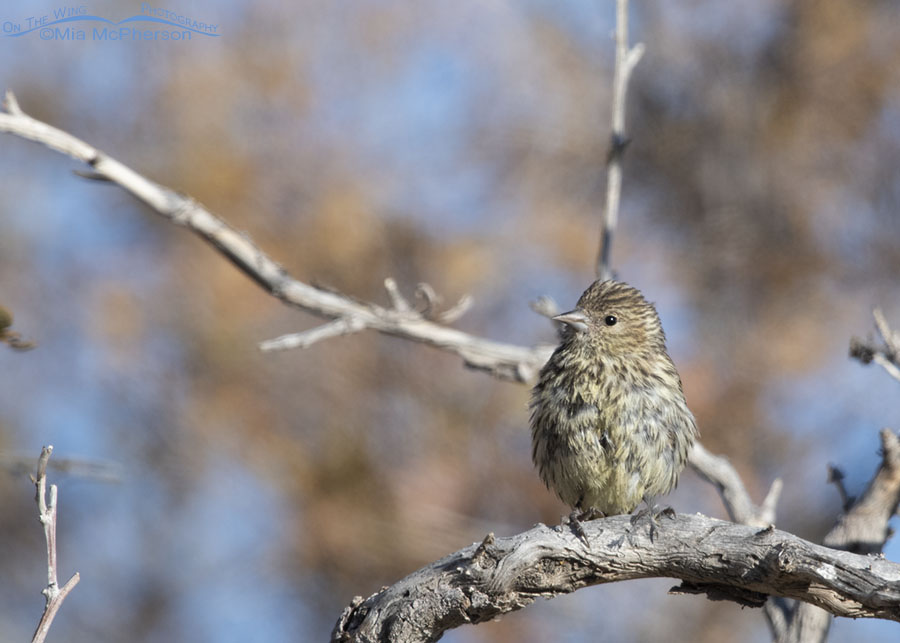 Damp Pine Siskin at a freshwater spring – Nikon D500, f7.1, 1/1250, ISO 500, Nikkor 500mm VR with 1.4x TC, natural light
Damp Pine Siskin at a freshwater spring – Nikon D500, f7.1, 1/1250, ISO 500, Nikkor 500mm VR with 1.4x TC, natural light
My Facebook timeline is buzzing with people posting photos of large numbers of Pine Siskins at their bird feeders across the country. This isn’t surprising since so far 2020 seems to be an irruptive year for these small finches. Some of the photos I have seen have shown 50 or more siskins on the ground below people’s feeders.
I’ve seen photos of large numbers of Pine Siskins from the Northeast, Montana, and south to New Mexico and I am certain I will be seeing more during this fall and winter.
What attracts Pine Siskins to feeders?
- Millet, thistle, nyger, hulled sunflower seeds, and suet.
If you are using any of those at your feeders you might see lots of siskins this fall.
Where in the country can Pine Siskins be found this fall and winter?
- Practically anywhere in southern Canada and the Lower 48 in the U.S. See this map.
 Pine Siskin perched in a sumac in the fall – Nikon D500, f7.1, 1/2000, ISO 500, Nikkor 500mm VR with 1.4x TC, natural light
Pine Siskin perched in a sumac in the fall – Nikon D500, f7.1, 1/2000, ISO 500, Nikkor 500mm VR with 1.4x TC, natural light
Both of these photos were taken in northern Utah on October 15, 2017.
I usually hear Pine Siskins before I see them, their calls are distinctive to my ears. I understand that some people have a hard time hearing their calls. I hear that buzzing “zreeeeeeet” and instinctively start looking around for these small finches.
Pine Siskins blend into their habitat easily and sometimes pointing them out to other people can be a challenge or even a major pain in the rear end.
I don’t have bird feeders set up but I do see large numbers of Pine Siskins out in the field during the fall and winter here in northern Utah and I am hoping to see more soon.
Here are a few articles about the 2020 irruption of Pine Siskins:
The pine siskin causes irruption in New Mexico
Pine Siskin – 2020 an Invasion Year
Irruption Alert: Pine Siskins Are On The Move
Have you been hearing and seeing Pine Siskins? Keep a look out, they may be heading your way soon!
Life is good.
Mia
Click here to see more of my Pine Siskin photos plus facts and information about this species.


Ah, that explains it! We have a largeish flock of siskins. I need to get them something to eat, so they’ll stay around. I’ve mostly given up on niger. I guess it’s too old for them. Since it’s time to go to the feed store for the chi-chi kibble for our fussy dog, I’ll check to see what specialty bird seeds they have in stock.
I have all they need at the birdy buffet, I will have to watch for them. The only thing I don’t like about large numbers of siskins is they tend to carry Salmonella. I normally wash down my feeders once a week and keep my feeding area clean, but during the winter I wash them once a month normally, but when the siskins are here I have to wash them every week. I have to bring the feeders in and run them through the dishwasher. My feeders are a tough plastic so I can wash them. I stopped using wood because of the pathogens it holds onto.
Oh goody! I had a couple last year so maybe will get to see more this year. Hoping the Red breasted Nuthatches make it to the Ozarks this year too. Bought 50# of sunflower seeds this week, will have to get my peanut butter mixture supplies in too. Still warm, no frost yet.
Fascinating and it explains what I saw recently. I encountered a few Pine Siskins intermixed with a small flock of Lesser Goldfinches. That wasn’t particularly surprising. However, the location came as a surprise — the farmlands between Tucson and Phoenix, which consist of reclaimed desert. I often see Pine Siskins in southern Arizona’s mountains, but have never encountered one previously in the desert lowlands, an elevation that is several thousand feet below the siskins’ typical mountain habitat in these parts. I’ll be posting some images in my blog soon.